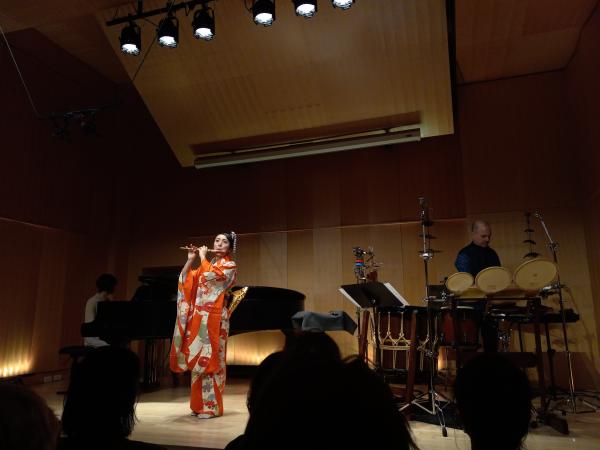Yuki Isami of TEKE::TEKE Dazzles At Rives Album Launch Show

When most people think of Montreal group TEKE::TEKE, they think of loud abrasive punk, but then they also think of 60s psych, Japanese folklore and traditional Bulgarian music. Well, actually when people think of TEKE::TEKE they think of a lot of things. That is very much because the group is composed of seven members with various musical and cultural backgrounds. And with their stream-of-consciousness and jam-style approach to songwriting, their music is always fascinating, innovative and original.
A significant element of the group’s sound is the powerful, yet delicate, flute floating over the band’s pulsing rhythms. The person behind the flute is the very talented Yuki Isami. Born in Japan, Isami came to Montreal to study music at the studio of Claire Marchand at the McGill Conservatory. She is an accomplished player, performing in many different symphonies and in festivals across the world. To add to her repertoire, she also plays other traditional Japanese instruments such as the Shinobue, Shamisen, and Koto. And to add the final puzzle piece to her personality, she is also a synchronized swimmer.
Such an accomplished musician who forges their own path is the perfect fit for the band of pirates that makes up TEKE::TEKE. On their latest album Hagata, Isami’s playing can be heard playfully coming in and out, completing songs with twists and surprises. But, there is a particular track on the album, that doesn't last more than two minutes, called “Me No Haya” that is a little different from the rest. In this track, the focus is on Isami’s flute with the band slowly introducing their parts as the song blossoms before coming to its close. This track acts as a teaser for Isami’s debut album, where listeners are now granted the time to see her inspirations and interpretations expanded upon.
What makes her album Rives so fascinating is that Isami selected pieces that she found best reflected Japanese traditional music, but also how it adapted over time after the exposure of more Western-style compositions. The latter half of the album does the opposite and highlights Western compositions that were influenced by Eastern counterparts. In the press release, Isami talks about this cultural exchange as a reflection of her experiences of being a dual citizen of both Canada and Japan. The album is mysterious, and sometimes dark but always sharp and with purpose. Isami, alongside pianist Natsuki Hiratsuka and percussionist Patrick Graham, brought Rives to the stage on May 17th for the album’s launch show.
The stage was set at Salle Joseph Rouleau, a small venue on Mont Royal that most of us are used to walking past. The venue was humble but impressive in its acoustic treatment of the room. With the beautiful pine-coloured wood surrounding the stage, the room was glowing as if it were hit with sunshine. Isami took the stage at first dressed in a full kimono complete with zori sandals and tabi socks. The first act comprised of pieces from the album, again which were the Japanese songs interpreted or adapted due to Western influences and in this section she played up to three different traditional Japanese flutes. For Act 2, Isami and her players quickly went off stage with the flutist returning in a shimmering aqua blue gown, complete with thick dazzling silver jewelry, and from what I could tell at least 6-inch heels. She explained that in the next segment, it was a new era with new songs and a new flute, therefore she needed a new dress. In a reversal from Act One, Isami was now playing European pieces that changed after exposure to Japanese music. The highlight was on Debussy, of which the singer spoke of his adoration of Japanese culture. In this next segment, pianist Natsuki Hiratsuka really got to shine and percussionist Patrick Graham completed the pieces with his never-ending treasure chest of tools, which acted as his drum kit. For Act 3, Isami paid tribute to master composer Toru Takemitsu. In a fascinating piece entitled “Voice”, Isami performed with unusual techniques such as slamming her fingers on the flute, delivering piercing, sharp blows of air and shouting phrases in between notes at a rapid pace. This very experimental piece was again an attestation to her musical ability and also her diverse interests as an artist.
The performance felt all too short, but the crowd couldn’t complain as they were met with imported sake from Nico Fujita and hors d’oeuvres prepared by the team of Tomokazu Murakami in the lobby. The energy in the room was excited and buzzing, as audience members approached the glowing artist to give her their praises. It was heartwarming to see Yuki Isami shine on her night, a perfect concert which seemed to be truly curated by her own dreams.
Lisa Rupnik is the head music director at CJLO and co-host of The Last Stop. She is also an avid record collector, a “no nonsense” film lover and feels that her personality can be best defined by her two favourite bands: YMO and Sparks




